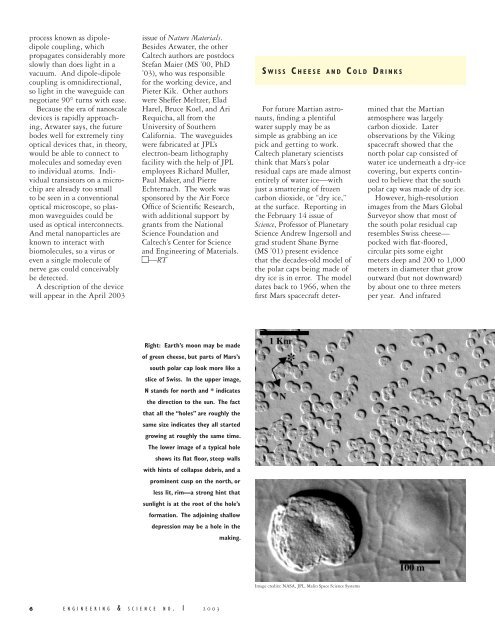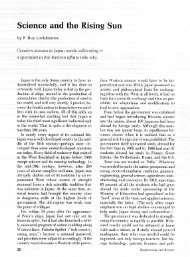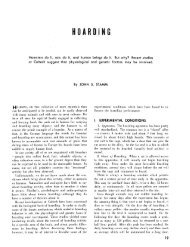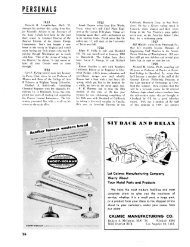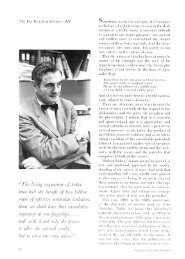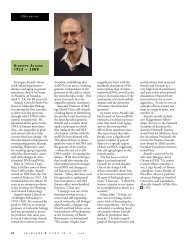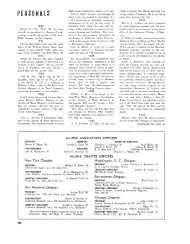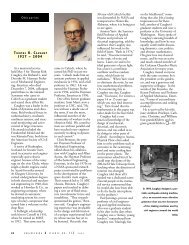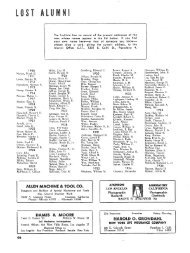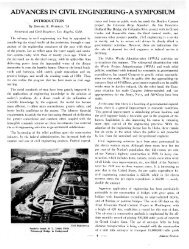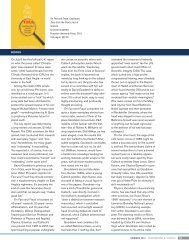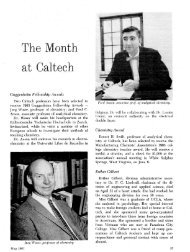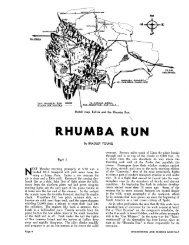indicates - Engineering & Science - California Institute of Technology
indicates - Engineering & Science - California Institute of Technology
indicates - Engineering & Science - California Institute of Technology
You also want an ePaper? Increase the reach of your titles
YUMPU automatically turns print PDFs into web optimized ePapers that Google loves.
process known as dipoledipole<br />
coupling, which<br />
propagates considerably more<br />
slowly than does light in a<br />
vacuum. And dipole-dipole<br />
coupling is omnidirectional,<br />
so light in the waveguide can<br />
negotiate 90° turns with ease.<br />
Because the era <strong>of</strong> nanoscale<br />
devices is rapidly approaching,<br />
Atwater says, the future<br />
bodes well for extremely tiny<br />
optical devices that, in theory,<br />
would be able to connect to<br />
molecules and someday even<br />
to individual atoms. Individual<br />
transistors on a microchip<br />
are already too small<br />
to be seen in a conventional<br />
optical microscope, so plasmon<br />
waveguides could be<br />
used as optical interconnects.<br />
And metal nanoparticles are<br />
known to interact with<br />
biomolecules, so a virus or<br />
even a single molecule <strong>of</strong><br />
nerve gas could conceivably<br />
be detected.<br />
A description <strong>of</strong> the device<br />
will appear in the April 2003<br />
issue <strong>of</strong> Nature Materials.<br />
Besides Atwater, the other<br />
Caltech authors are postdocs<br />
Stefan Maier (MS ’00, PhD<br />
’03), who was responsible<br />
for the working device, and<br />
Pieter Kik. Other authors<br />
were Sheffer Meltzer, Elad<br />
Harel, Bruce Koel, and Ari<br />
Requicha, all from the<br />
University <strong>of</strong> Southern<br />
<strong>California</strong>. The waveguides<br />
were fabricated at JPL’s<br />
electron-beam lithography<br />
facility with the help <strong>of</strong> JPL<br />
employees Richard Muller,<br />
Paul Maker, and Pierre<br />
Echternach. The work was<br />
sponsored by the Air Force<br />
Office <strong>of</strong> Scientific Research,<br />
with additional support by<br />
grants from the National<br />
<strong>Science</strong> Foundation and<br />
Caltech’s Center for <strong>Science</strong><br />
and <strong>Engineering</strong> <strong>of</strong> Materials.<br />
■—RT<br />
Right: Earth’s moon may be made<br />
<strong>of</strong> green cheese, but parts <strong>of</strong> Mars’s<br />
south polar cap look more like a<br />
slice <strong>of</strong> Swiss. In the upper image,<br />
N stands for north and * <strong>indicates</strong><br />
the direction to the sun. The fact<br />
that all the “holes” are roughly the<br />
same size <strong>indicates</strong> they all started<br />
growing at roughly the same time.<br />
The lower image <strong>of</strong> a typical hole<br />
shows its flat floor, steep walls<br />
with hints <strong>of</strong> collapse debris, and a<br />
prominent cusp on the north, or<br />
less lit, rim—a strong hint that<br />
sunlight is at the root <strong>of</strong> the hole’s<br />
formation. The adjoining shallow<br />
depression may be a hole in the<br />
6 E N G I N E E R I N G & S C I E N C E N O . 1 2 0 0 3<br />
making.<br />
S W I S S C H E E S E A N D C O L D D R I N K S<br />
For future Martian astronauts,<br />
finding a plentiful<br />
water supply may be as<br />
simple as grabbing an ice<br />
pick and getting to work.<br />
Caltech planetary scientists<br />
think that Mars’s polar<br />
residual caps are made almost<br />
entirely <strong>of</strong> water ice—with<br />
just a smattering <strong>of</strong> frozen<br />
carbon dioxide, or “dry ice,”<br />
at the surface. Reporting in<br />
the February 14 issue <strong>of</strong><br />
<strong>Science</strong>, Pr<strong>of</strong>essor <strong>of</strong> Planetary<br />
<strong>Science</strong> Andrew Ingersoll and<br />
grad student Shane Byrne<br />
(MS ’01) present evidence<br />
that the decades-old model <strong>of</strong><br />
the polar caps being made <strong>of</strong><br />
dry ice is in error. The model<br />
dates back to 1966, when the<br />
first Mars spacecraft deter-<br />
Image credits: NASA, JPL, Malin Space <strong>Science</strong> Systems<br />
mined that the Martian<br />
atmosphere was largely<br />
carbon dioxide. Later<br />
observations by the Viking<br />
spacecraft showed that the<br />
north polar cap consisted <strong>of</strong><br />
water ice underneath a dry-ice<br />
covering, but experts continued<br />
to believe that the south<br />
polar cap was made <strong>of</strong> dry ice.<br />
However, high-resolution<br />
images from the Mars Global<br />
Surveyor show that most <strong>of</strong><br />
the south polar residual cap<br />
resembles Swiss cheese—<br />
pocked with flat-floored,<br />
circular pits some eight<br />
meters deep and 200 to 1,000<br />
meters in diameter that grow<br />
outward (but not downward)<br />
by about one to three meters<br />
per year. And infrared


